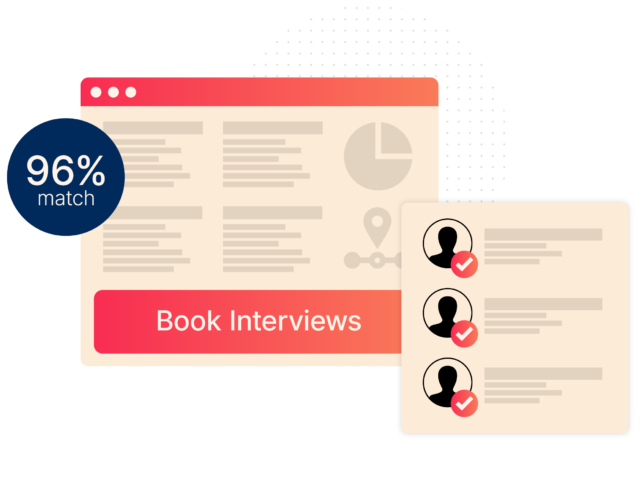How to Stand Out in a Competitive Job Market: Tips For Applicants and Businesses

More than ever, the competitive job market demands that people differentiate themselves from the rest. And not just applicants vying for a limited number of jobs—businesses also need a competitive advantage to compete with one another for the best staff.
The job market is very competitive today, perhaps too competitive. As more qualified candidates compete for fewer openings, it can be harder for applicants to capture the attention of prospective employers, just as it is harder for companies to distinguish themselves and present a value proposition that will appeal to tomorrow’s business leaders.
In this blog, we’ll examine useful hints and tips on how job seekers can make an impression and how businesses can identify top candidates.

What Is a Competitive Job Market?
A competitive job market has more qualified candidates than there are positions available. In such a market, job seekers face direct competition for a limited number of roles. Meanwhile, employers have a larger pool of potential job candidates to choose from, which allows them to be more discriminating in their hiring process.
Why is the job market so competitive right now?
Several factors contribute to the current competitive nature of the job market:
- Economic factors: Economic uncertainty and change can make for fewer options and more competition for job seekers.
- Technological advancements: This often drives down demand in many specific job roles and skills while driving up demand in certain highly specialized job roles and skills.
- Globalization: As the world embraces remote work and global connectivity, employers can tap into a larger talent pool, increasing the competition for jobs across borders.
- Skill gaps: There often needs to be a better match between the skills job seekers possess and the skills employers require, leading to increased competition for roles that demand specific skill sets.
- Demographic shifts: As younger generations enter the workforce and older generations remain in their roles longer, there is increased competition across age groups.
Which particular job market is the most competitive?
Competition often depends on the industry, location, and job type, but some of the most competitive job markets are:
- Technology: The fast pace of innovation and the always-changing nature of the tech sector make it highly competitive, with many well-qualified applicants battling for positions in software development, data science, and cybersecurity.
- Healthcare: The rising demand for healthcare services, together with the need for specific skills and certifications, makes the healthcare job market saturated.
- Finance: The finance sector is fast-paced and highly competitive; in particular, investment banking, financial analysis, and accounting roles are very competitive and attract many qualified applicants.
- Creative fields: Creative fields like marketing, advertising, and design are fiercely competitive. Many individuals are seeking to demonstrate and exhibit their talents, making it challenging to capture the interest of prospective clients and employers.
How to Get a Job in a Competitive Market: 13 Tips For Candidates
Securing employment today in a competitive market can be challenging. But by developing the right strategies and mindset, you can significantly increase your odds of finally getting a foot on the employment ladder.
Here are 13 top ideas to ace your job search and secure your dream position.
1. Practice patience
Finding a new role can take a while. If you have no luck with an application, don’t take it personally. Keep your profile up-to-date, send more applications, and take advice on board with every rejection.
2. Gain relevant work experience
Employers often prioritize candidates with relevant experience. Do some internships, part-time jobs, freelance work, or project commissions in your field, so you’ve earned the right to apply.
3. Participate in volunteer work
Volunteering in your community or industry can give you valuable experience, expose you to others in the field, and demonstrate your dedication.
4. Further your education
Extra credentials can signal that you’re a Good Candidate for a job role. Are there advanced degrees that apply to the role, or online courses or cross-training that you could seek out? Do any professional certifications exist for your field?
5. Network actively
Go to industry networking events. Join social networking sites for professionals. Get in touch with alumni from your school. Relationships can unlock better information about work opportunities ahead of time and potent job references.
6. Tailor your resume for each job
Customize your resume to emphasize the skills and experience that align with each job application. Use keywords from the job description to demonstrate your fit for the role.
7. Create a professional online profile
You can be sure that many employers will look you up online. So, it makes sense to ensure that your social media profiles (particularly on LinkedIn) are updated and showing you in the best light possible.
8. Develop leadership skills
Employers value candidates with strong leadership abilities. Look for opportunities to practice leadership—on the job, in a volunteer organization, or at a professional association.
9. Keep up with market trends
Find out what’s happening in your industry. Read industry papers, attend conferences, and follow thought leaders on social media. Show that you know what’s happening.
10. Prepare for your interview
Look up the company and the position before your interview. Practice the questions you’ll be asked, and have a few specific examples prepared to illustrate your particular skills and experience. Be ready to explain why you’re the best candidate.
11. Join professional associations
Membership in professional associations in your industry can provide access to job boards, networking opportunities, and professional development. This will help you stay up-to-date on jobs and meet prospective employers.
12. Secure good references
Find former superiors, co-workers, or university professors who know your skills and work habits well, and keep them updated on your job-search activities by sending them updated versions of your resume or portfolio. Good references can make all the difference for an employer.
13. Stay flexible
You must be open to new opportunities. Explore other fields and roles, perhaps with transferrable skills. Be open to contingent work—temporary or on contract—as a path to ‘real’ jobs.

How to Stand Out in a Competitive Job Market: 10 Tips For Businesses
In a highly competitive job market, businesses must fight harder than ever to get and keep the best people. You must distinguish your company from the rest and convince potential prospects that it’s a great place to work.
These 10 tips can help you attract the most qualified people for your open positions.
1. Strong employer brand
Create an employer brand that reflects your company and tells your story: your values, culture, and mission. An Employer Brand helps attract candidates who are a better fit for your goals and more likely to succeed.
2. Competitive compensation
Offer attractive salary and benefit packages to attract top talent. Review and adjust your compensation structure to align with industry standards and employee expectations. Consider clearly outlining On Target Earnings in job descriptions to provide candidates with a realistic understanding of their potential compensation.
3. Career development
Create well-defined career paths within your company so employees have tangible goals to strive for. Offer training programs and mentorship opportunities to show employees you invest in their future.
4. Flexible work options
In the current job market, most candidates place value on flexibility. Therefore, try offering remote work or hybrid work environments and flexible schedules to increase the number of qualified candidates.
5. Positive candidate experience
Try to make every element of the hiring process as smooth as possible. A good candidate experience coupled with effective employer branding activities will help your organization gain a reputation as a great workplace, which in turn can help you attract the best talent.
6. Streamline your hiring process
Ensure your hiring process is efficient and candidate-friendly. Effective ATS Software will help you handle incoming applications, manage candidate communications, and coordinate with your hiring team. A streamlined process can mean the difference between getting your desired hire before one of your competitors.
7. Target passive job seekers
Don’t limit your recruitment efforts to active job seekers; also reach out to passive candidates (people not actively looking for a job change but possessing the skills your business needs). LinkedIn and other professional social networks offer good tools to identify and engage those passive candidates.
8. Take advantage of social media
Utilize social media to promote your employer brand. By posting employee success stories and advocating your employee-focused culture, you can appeal to an audience where the message truly resonates.
9. Highlight referrals
Ask your current employees for referrals from their networks. Employee referrals are one of the top sources of talent because referred candidates are more likely to be a great cultural fit and understand your organization.
10. Use your recruiting data effectively
Base your recruitment strategies on data, driven by analytics. Use Talent Insights to track KPIs, surface disparities, and make hiring decisions at every stage of the talent cycle with richer, more diverse data.
11. Partner with a professional staffing firm
Consider hiring a staffing agency that specializes in your industry. Staffing firms have access to a large candidate pool and can search for talent quickly and efficiently.
12. Embrace diversity and inclusion
Prioritize diversity and inclusion in your recruitment efforts. Use Diversity Recruiting Software to reduce bias in the hiring process. A more diverse approach can attract more people to apply by showing that your company is open-minded and promotes inclusivity.
Key Challenges Businesses Face in a Competitive Job Market
In a cut-throat job market, businesses encounter various challenges that can hinder their ability to attract and retain top talent. Understanding and addressing these hurdles is crucial for organizations to remain competitive and successful in their recruitment efforts.
1. Attracting qualified candidates
One of the biggest challenges facing businesses in a competitive talent market is luring the right candidates to apply. Given that most companies are looking to recruit from the same talent pool, it can be difficult to get noticed by the best and brightest in your field.
2. Retaining top talent
The greater the demand for skilled personnel, the higher the risk that your best employees will be tempted by other companies with greater incentive packages or growth potential.
3. Adapting to changing candidate expectations
Candidate expectations increasingly focus on factors such as work-life balance, flexible work arrangements, and professional development. Companies desiring to recruit and retain top talent need to recognize that they are in fierce competition to meet these expectations and continue to adjust their policies and procedures accordingly.
4. Managing a lengthy hiring process
In a competitive market, hiring can be a long and complicated process, often involving thorough candidate evaluations. The challenge, of course, is to keep the process as streamlined as possible while maintaining the desired standards.
5. Offering competitive compensation and benefits
Attractive pay and perks can engage and keep the best candidates. But for many businesses (especially small and medium-sized enterprises), it’s a struggle to compete with their larger multinational competitors regarding salaries and benefits.
How can businesses measure their success in a crowded job market?
To effectively navigate the challenges of a competitive job market, businesses must establish clear metrics for measuring their success in attracting and retaining top talent. Some key performance indicators (KPIs) to consider include:
- Time-to-hire: Track the average time required to fill open jobs, from initial job posting to offer acceptance. A shorter Time-To-Hire can indicate a more efficient recruitment process and a competitive advantage in securing top candidates.
- Offer acceptance rate: How many offers do candidates accept once hired? High offer acceptance rates may indicate that your company’s offers are competitive relative to the market or that the candidate experience you’re delivering before and during the interview process is helping to sway talent your way.
- Retention rate: Measure the percentage of employees who stay with your company over a set period. High retention rates represent a good employer brand, competitive compensation and benefits for staff, and a positive work environment.
- Employee satisfaction: Use surveys and feedback sessions to track employee satisfaction regularly. Greater satisfaction among employees may increase employee retention rates and help build your employer brand.
- Quality of hire: Examine how well new hires perform and remain with your organization. When your hires are high-quality—i.e., they contribute to your organization’s objectives and fit with your culture—then chances are your recruiting process was effective.
What Role Does Technology Play in a Competitive Job Market?
From automating repetitive tasks to providing data-driven insights, technology empowers businesses to streamline their recruitment processes, make informed decisions, and ultimately build stronger, more competitive teams.
Let’s explore some key ways technology is reshaping the job market:
- Artificial Intelligence (AI) and Machine Learning (ML): AI and ML algorithms are great for automating candidate screening, Resume Parsing, and initial interviews. By leveraging these technologies, your company can move quickly to catch the top candidates before your competitors, reduce the time-to-hire process, and remove the human error of hiring bias.
- Applicant Tracking Systems (ATS): ATS software automates the entire recruiting process, from job postings to offer management. It helps recruiters store candidate information, collaborate with other hiring team members, and provide ease of use for candidates. ATS can allow companies to manage a large number of applications effectively while at the same time avoiding losing out on a possible best candidate.
- Recruitment CRM: Also known as a candidate relationship management system, a Recruitment CRM is software designed to help a business manage and develop relationships with top talent before positions open. It houses all candidate data and communication in one place, allowing employers to establish targeted talent pipelines and personalize candidate communication and experiences
- Data Analytics: Technology allows insight into how an organization’s hiring strategy and talent pool function by collecting and analyzing large quantities of recruitment data. Data analytics can thus, for example, reveal processes prone to ‘snags’ and help refine a company’s recruitment strategies and competitive position in the job market.

Oleeo’s Powerful Suite of Recruitment Software Helps Your Company Stand Out in a Competitive Job Market
Oleeo offers a comprehensive suite of recruitment software designed to help organizations thrive in an increasingly competitive jobs market. Our products and services encompass everything a business needs to optimize recruitment, from applicant tracking and candidate relationship management to Diversity Recruiting, reporting, and analytics.
Stop letting the competition hold your business back. Request A Demo of Oleeo’s powerful recruitment software today and see how you can get ahead of the pack in attracting and retaining the best and brightest.
FAQs about Competitive Job Markets
How can businesses retain top talent?
A workplace that fosters good morale and cooperation between employees is more likely to have a higher retention rate. Besides, senior management should always acknowledge the noteworthy accomplishments of its workers to show support.
How can businesses improve their employer brand?
Businesses can enhance their employer brand by clearly defining and communicating their unique value proposition, displaying their company culture, and fostering employee advocacy.
What are the key skills employers seek in a competitive job market?
Employers want candidates with technical and soft skills such as adaptability, strong communication, good problem-solving, emotional intelligence, and a lifelong learning mindset.
How can candidates effectively research potential employers?
Candidates can collect information about prospective employers through the company website, employee reviews, networking with current or formerly employed individuals, and attending company events.



